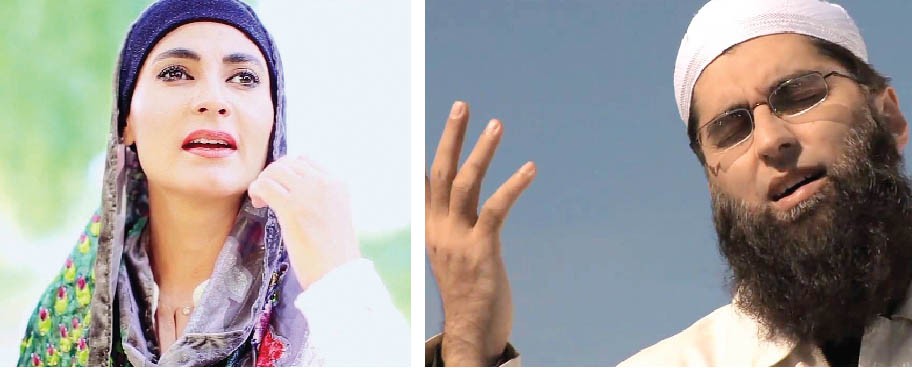
It is strange how vocalists these days abandon a major form of music and its vaulted status and move to a subsidiary stream

Time to time, a performing artiste or a painter issues a statement that they had given up acting or music or painting, and now intend to devote the creative energies and time to a more respectable cause. Recently, it was reported in the media that Fariha Pervez has decided to give up the kind of singing that she had been doing and will only be rendering the sufiana kalam.
Such an act is supposed to be received by voices of self-righteous approval that the person has finally repented and seen the light.
Whatever the worth of Junaid Jamshed, the entire focus of the media mourning was directed at his giving up singing while restricting himself to the rendering of naats, hamds and the so-called sufiana kalam. This change or a transformation was hailed as a great step towards a more acceptable and respectable lifestyle. During the frenzy of his mourning that lasted a few days, there were constant replays of some of the naats or hamds that he had rendered. The general people received these as acts of religious practice and ritual and an affirmation of their own understanding of following of the right path.
These shifts have happened in our history of the arts but mostly in the other direction. During the rise of the kheyal in the eighteenth century and its complete domination during the nineteenth century, a movement or a change in exactly the opposite direction was seen. It had been believed by many that qawwali began in the era of Amir Khusro when he, emulating the religious music of the people living in this area, rendered the qawls on the shrine of the Chishtia sufia and those mystics on the extreme like the qalandars in the early period of Muslim rule in the subcontinent.
All those centuries, the musical form of the qawwali that evolved was particularised by its performances on the shrine, the quasi-religious musical rendering performed on Thursdays/Fridays and on the urs of the sufi saint. It had little presence outside the precincts of the shrine. As dhrupad dominated the major classical stream, it was much eulogised and acclaimed by the musicians and connoisseurs of music. It was said in derision that a bigra gawaiya became a qawwal and a bigra shair became a marsiago. The most talented vocalists among the lot switched over to mainstream music.
Qawwali must have continued as a parallel minor tradition all these centuries and the name of Hussain Sharqui Jaunpuri was also mentioned in relation to the music performed on the shrine. With the rise of the kheyal in the eighteenth century, it is generally surmised that the non dhrupad vocalists took up this form with relish rather than the mainstream gawaiyas, and ustads like Barre Muhammed Khan considered by many to be one the founding vocalists of kheyal was actually from the "qawwal bachcha" lineage. This was then taken up by his equally talented son Barre Mubarak Khan as he fully formalised this new form of singing to a level where it was perceived to be ready to replace the more majestic and awe inspiring dhrupad.
It is said that Taan Rus Khan too was a "qawwal bachcha" as he was spotted singing on the shrine. His talent was so obvious that he was made to quit the qawwali, become a kheyalia and we all know through reputation that he became the leading kheyal vocalists who is remembered in anecdotal regurgitation with awe and fondness even today.
The founding fathers of the various gharanas of the kheyal were the descendents of Mian Shori who had incorporated the tappa into the genre of high music probably in the court of the Awadhi nawabs in Lucknow. Then his progeny spread out across northern subcontinent and founded the various gharanas in the next hundred years or so.
It is ironic that musicians in the past moved from a minor form to a major form where the musical form was autonomous and not seen as a handmaiden to either religion or politics. The move from qawwali to kheyal can be seen in this light but it is strange how these days, from an autonomous form, vocalists move to a subsidiary stream and abandon its vaulted status.
It can be questioned whether top-of-the-line musicians have started to make the changeover in this time and age. The two artistes mentioned above were and are not top-of-the-line and could have sought openings outside their main area of activity, seeking help from extra musical quarter, in a society that considers itself uneasily disposed towards music.
Nusrat Fateh Ali Khan, keenly conscious of the tradition of music, insisted that he be allowed to sing the kheyal and his raag champak was liked by many. Knowing the hierarchical order of music forms, he set aside his immensely popular qawwali numbers and rendered the kheyal before initiated audiences even in his prime.
But present times are strange when things have been put on their head and abandoning mainstream musical forms for something that is an ancillary expression is being popularly perceived as a step in the right direction. In the arts particularly the performing arts’ readjustment and approval, like in all other areas of present times, the ultimate authority that is sought is that of religion as understood by the layman. So music too needs to be justified and seen in the context of whether it is performing a religious function or not.
One wonders whether any top-of-the-line vocalists or instrumentalists in history ever succumbed under peer pressure.
This article was published in The News on Sunday on February 05, 2017 under the title A shift to the other direction.